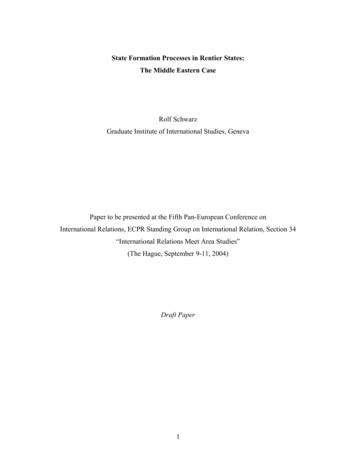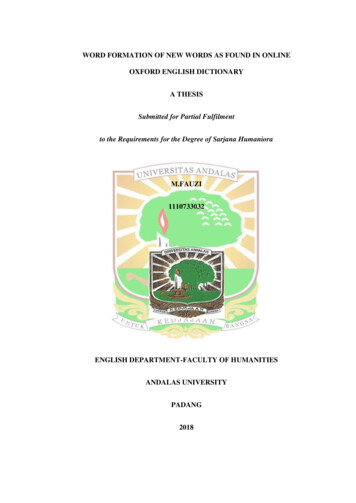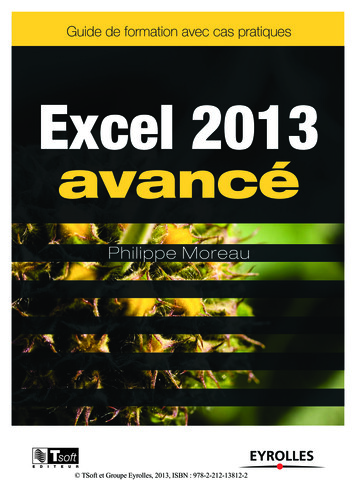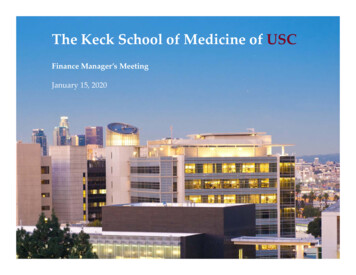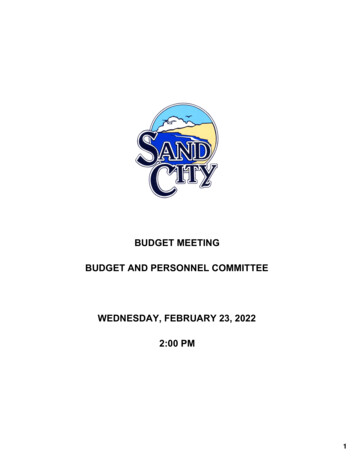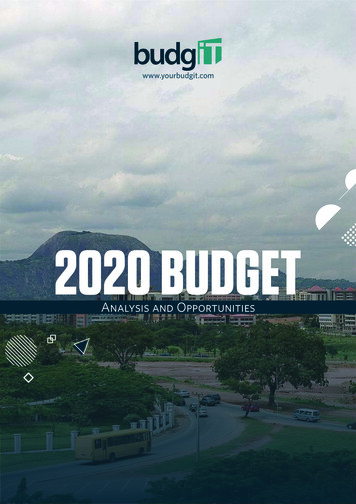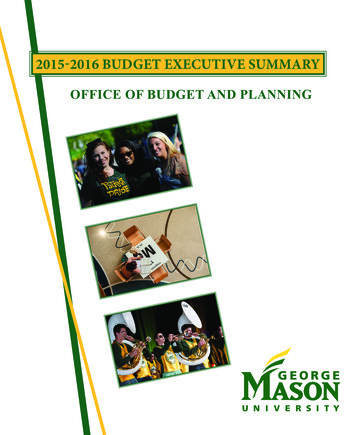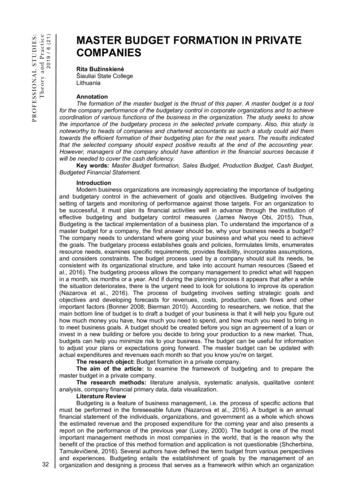
Transcription
2019 / 6 (21)P ROF ESS IONAL S TUD I ES :Theo r y a nd P ra ct ic e328MASTER BUDGET FORMATION IN PRIVATECOMPANIESRita BužinskienėŠiauliai State CollegeLithuaniaAnnotationThe formation of the master budget is the thrust of this paper. A master budget is a toolfor the company performance of the budgetary control in corporate organizations and to achievecoordination of various functions of the business in the organization. The study seeks to showthe importance of the budgetary process in the selected private company. Also, this study isnoteworthy to heads of companies and chartered accountants as such a study could aid themtowards the efficient formation of their budgeting plan for the next years. The results indicatedthat the selected company should expect positive results at the end of the accounting year.However, managers of the company should have attention in the financial sources because itwill be needed to cover the cash deficiency.Key words: Master Budget formation, Sales Budget, Production Budget, Cash Budget,Budgeted Financial Statement.IntroductionModern business organizations are increasingly appreciating the importance of budgetingand budgetary control in the achievement of goals and objectives. Budgeting involves thesetting of targets and monitoring of performance against those targets. For an organization tobe successful, it must plan its financial activities well in advance through the institution ofeffective budgeting and budgetary control measures (James Nwoye Obi, 2015). Thus,Budgeting is the tactical implementation of a business plan. To understand the importance of amaster budget for a company, the first answer should be, why your business needs a budget?The company needs to understand where going your business and what you need to achievethe goals. The budgetary process establishes goals and policies, formulates limits, enumeratesresource needs, examines specific requirements, provides flexibility, incorporates assumptions,and considers constraints. The budget process used by a company should suit its needs, beconsistent with its organizational structure, and take into account human resources (Saeed etal., 2016). The budgeting process allows the company management to predict what will happenin a month, six months or a year. And if during the planning process it appears that after a whilethe situation deteriorates, there is the urgent need to look for solutions to improve its operation(Nazarova et al., 2016). The process of budgeting involves setting strategic goals andobjectives and developing forecasts for revenues, costs, production, cash flows and otherimportant factors (Bonner 2008; Bierman 2010). According to researchers, we notice, that themain bottom line of budget is to draft a budget of your business is that it will help you figure outhow much money you have, how much you need to spend, and how much you need to bring into meet business goals. A budget should be created before you sign an agreement of a loan orinvest in a new building or before you decide to bring your production to a new market. Thus,budgets can help you minimize risk to your business. The budget can be useful for informationto adjust your plans or expectations going forward. The master budget can be updated withactual expenditures and revenues each month so that you know you're on target.The research object: Budget formation in a private company.The aim of the article: to examine the framework of budgeting and to prepare themaster budget in a private company.The research methods: literature analysis, systematic analysis, qualitative contentanalysis, company financial primary data, data visualization.Literature ReviewBudgeting is a feature of business management, i.e. the process of specific actions thatmust be performed in the foreseeable future (Nazarova et al., 2016). A budget is an annualfinancial statement of the individuals, organizations, and government as a whole which showsthe estimated revenue and the proposed expenditure for the coming year and also presents areport on the performance of the previous year (Lucey, 2000). The budget is one of the mostimportant management methods in most companies in the world, that is the reason why thebenefit of the practice of this method formation and application is not questionable (Shcherbina,Tamulevičienė, 2016). Several authors have defined the term budget from various perspectivesand experiences. Budgeting entails the establishment of goals by the management of anorganization and designing a process that serves as a framework within which an organization
MethodologyMaster budget is the sum total of all the divisional budgets that are prepared by all thedivisions. It also includes the financial planning, cash-flow forecast, and budgeted profit and lossaccount and balance sheet of the organization. Normally the master budget is prepared for ayear. Sometimes, it may be misunderstood that the master budget is one large budget of theorganization. However, it is not the case. Master Budget is a summary of the divisional budget.It is a continuous financial plan (Sizer 2003, Ackaha and etc., 2014). The components of thebudget are presented in Figure 1.Sales BudgetEnding FinishedGoods BudgetProduction BudgetDirect MaterialsBudgetDirect Labor BudgetSelling andAdministrative BudgetManufacturingOvearhead BudgetCash BudgetBudgeted Financial StatementsFig. 1. The Components of Master BudgetSources: Nazarova et al., 2016; Shcherbina, Tamulevičienė, 2016; Rakos, Man, 2016;Raghunandan et al., 2012; Ackaha et.al. 2014; Appiah-Mensah Kwame et.al. 2007; Arora,2006.The sales budget is the foundation of the master budget. This plan is very difficult tocome by because the demands for the company product to market customers are not just to bedetermined, this is due to the nature of competition in the market. First and foremost, thenumber of units to be sold and price per unit are derived. On the basis of that, the value of salesis calculated. All the procurements, staff requirements and administration costs are based onthe sales. The factors to be considered in sales forecasting are: Past sales; Reports bysalesmen company conditions; Business conditions; Market demand estimation; Productioncapacity or an infrastructure facility; Current supply facility; Industry analysis; Market demandand production capacity are determined with the help of Marketing division and productiondivision respectively. The production budget is mainly based on the sales budget. It includes332019 / 6 (21)P ROF ESS IONAL S TUD I ES :Theo r y a nd P ra ct ic eeffectively articulates overall planned activities (Isaac, Lawal, Okoli, 2015). Budget is apredetermined statement of management policy during a given period which provides astandard for comparison with the result actually achieved (Brown and Howard, 2002). Thebudget is a comprehensive and co-ordinated plan expressed in financial terms for theoperations and resources of an enterprise and for some specific period in the future (Pandey,2001). On their part define a budget as a financial and/or quantitative statement prepared andapproved prior to being pursued during that period for the purpose of attaining a given objective(Buyers and Holmes, 2000). Budgets are an important tool of profit planning and budgets as atool of planning are closely related to the border system of planning in an organization (Khanand Jain, 1998). Budget as a financial or quantitative statement of a plan to be pursued forachieving a given objective (Aseshemic, 1997). A budget is based on past experience pluschanges in light of the current environment (Shim et al 2012). According to M. Robinson (2009),the budgeting process can help considers the case for reformulating fiscal policy in terms ofaccrual rather than cash aggregates as well. He notices the accrual budgeting system. Afteranalysis of the literature review, we notice, that the budget helps to evaluate organizationalplans, while at the same time performing two vital management functions namely: Theformulation of a comprehensive future plan of action; It compares actual result withpredetermined plan, thus, planning and control (which are two primary functions ofmanagement) are also essential features of the budgeting process. A budget can be used toindicate some of the following: The funds needed for labor and/or materials; For a newbusiness, total start-up costs; Your costs of operations; The revenues necessary to support thebusiness; A realistic estimate of expected profits.
2019 / 6 (21)P ROF ESS IONAL S TUD I ES :Theo r y a nd P ra ct ic ethe quantity of production, cost of production calculated, and manufacturing operations. Theirprimary function is to provide management with expenditure on production and the amount ofoutput to be determined in the year. The factors to be considered in production budgetforecasting are: Inventory at the beginning of the year; Inventory to be maintained at the end ofthe year; Number of units manufactured; Buffer stock to be maintained throughout the year. Ifthe company is not having a manufacturing unit, we require a number of units to purchaseinstead of the production budget. The production budget is divided into further three parts:Direct material budget; Direct labor budget and Manufacturing overhead budget. Directmaterial budget is a phase in the accounting budget that deals with preparations of a plan toestimate the quantity of raw materials and components required for the production demandedby the production department. It enables the procurement department in planning for theirpurchases. It assists the procurement officer in the preparations of the procurement budget. Itbrings facts for raw material control. Direct labor budget is a budget prepared to show anumber of labor workers to be used in the production of the company, in order to achieve itsbudget target. It does also include the cost of labor required for production. Manufacturingoverhead budget. The factory overhead budget is normally prepared to estimate the cost ofoverheads, and its mainly prepared by the production managers of the organization. Sellingand Administration Budget. For simplicity sake, selling and administration budgets have beencombined. In practice, a separate budget has been prepared: the sales manager prepares theselling budget and the administrative manager prepares that of the administration. They are theselling and administration costs expected to be incurred during the budget period. The cashbudget is the estimation of cash receipts and payments for a future period. The objective of thecash budget is to ensure that sufficient cash is available at all times to meet the level ofoperations that are outlined in the various budgets. On the basis of the sales and productionbudget, it is derived that what is the expected receipts and what are the expected payment.Receipt and payment cycle of the customer and supplier need to be analyzed. At this stage, theorganization decides whether the external borrowing is required or not. On the basis of theabove budgets, the budgeted income statement is prepared. The budgeted income statementworks best when presented for all of the budget periods at once so that you can compare theresults for the various periods and spot anomalies that may require additional investigation. Thebudgeted balance sheet is prepared once the Budgeted Income Statement is prepared. Thebudgeted balance sheet indicates the following: A balanced budget is achieved when theestimated revenue equals the proposed expenditure in a given year. In given words, a balancedbudget is where an organization proposes in expenditure equal to the revenue. That’s amountto be received by the organization is the same as what to intend to spend (Colville, 1989; Arora,2006; Appiah-Mensah Kwame et.al. 2007; Raghunandan et al., 2012; Cox, 2013; Ackaha et.al.,2014; Rustamova et al., 2014; Rakos, Man, 2016; Hoffman, Reese, 2019).Results of Master Budget FormationMaster Budget was practically applied in the JSC “Snaige” (company). Company ispreparing a budget at the end of the accounting year (Table 1).Table 1The Sales BudgetComponentsBudgeted sales inthousand units1 quarter2 quarter3 quarter4 quarterAnnual39.7054.6158.7650.84203.91Selling price per unit, euros191.06191.06191.06191.06191.06Total budgeted sales,thousand euro7,58510,43311,2269,71438,958After analyzing of financial data of the company, we notice, that budgeted sales for thenext accounting years have to be 204 thousand units. The selling price should to be not to lessthan 191 euros (average value) per unit. Sales volume is calculated based on the 2017-2018sales results. The sales price is based on a margin of 11,5 percent multiplied by the estimatedproduction cost of 171,4 euro (Table 8). Budgeted sales equal 38,958 thousand euros.According to by company accounting policy all sales are on account 50 % collected in thequarter of sale, 35 % collected in the quarter following the sale, 15 % uncollectible (Table 2).348
1 quarter2 quarter3 quarter4 quarterAnnual5,3565,3561 quarter sales, thousand euro50 % x 75853,79235 % x 75853,7922,6552,6555,21752172 quarter sales, thousand euro50 % x 1043335 % x 104333,65236525,6135,6133 quarter sales, thousand euro50 % x 1122635 % x 112263,9293,9294,8574,85714,14235,0704 quarter sales, thousand euro50 % x 9714Total cash collections,thousand euro3,7927,8719,264The company will have been expected 35,070 thousand euro cash collections at the endof the accounting year. The management at the company expects, that ending inventory to beequal to 20 % of the following quarter’s budgeted sales in units. In 1 quarter, 7.9 thousand unitswere on hand (Table 3).Table 3The Production BudgetComponents1 quarter2 quarter3 quarter4 quarterAnnual4055595120410.911.810.210.910.9Total Needs51666962215Less: Beginning inventory7.910.911.810.27.9Total Reguired production,thousand units43555752207Budgeted Sales, thousandunitsAdd: Desired endinginventoryThe Production Budget consists of three parts: Direct Materials Budget; Direct LaborBudget; Manufacturing Overhead Budget. At the company, 5 pounds (assumed value) ofmaterial is required per unit of product. Management of the company would like materials onhand at the end of each quarter to 10% of the following quarter’s production. On 1 of thequarter, 21 pounds of materials are on hand. Material cost per pound is calculated by the primercost of production materials divide required production thousand units (Table 4).Table 4The Direct Materials BudgetComponents1 quarter2 quarter3 quarter4 quarterAnnualReguired production,thousand units43555752207Materials per unit (pounds)55555Production needs2132772862581,035Add: Desired endinginventory2829262727Total needed2413063122851,062Less: Beginning 4,9598,9329,8947,27130,603Materials to be purchased,thousand unitsMaterial cost, euro perpoundTotal direct materials,thousand euroThe company should expect a 24,9 thousand euro cash disbursement at the end of theaccounting year (Table 5). 60 % of a month’s purchases are paid for in the month of purchase;352019 / 6 (21)ComponentsAccounts receivableP ROF ESS IONAL S TUD I ES :Theo r y a nd P ra ct ic eTable 2Expected Cash Collections
2019 / 6 (21)P ROF ESS IONAL S TUD I ES :Theo r y a nd P ra ct ic e20 % is paid in the following quarter. The 1 of quarter accounts payable balance was being1,502 thousand euros.Table 5Expected Cash Disbursement For MaterialsComponentsAccounts payable - 01, January1 quarter2 quarter3 quarter4 quarter1,502Annual1,502April purchases60 % x 49592,9762,97660 % x 89329921,78660 % x 98945,3595,93660 % x 7271Total Cash disbursements,thousand 24,892Results show, that each unit of the product will have to be required 12 hours (assumedvalue) of direct labor. The Company has a “no layoff” policy so all employees will be paid for 40hours of work each week. In exchange for the “no layoff” policy, workers agree to a wage rate of1,5 euro per hour regardless of the hours worked (assumed no overtime pay). For the 1 quarter,the direct labor workforce will be paid for a minimum of 480 hours per quarter (Table 6).Table 6The Direct Labor BudgetComponents1 quarter2 quarter3 quarter4 quarterAnnualReguired production, thousandunits43555752207Director labor per unit1212121212Labor hours required5136656866192,483Guaranteed labor hours480480480480Labor hours paid5136656866192,484Hourly wage rate, euro/hour1.41.51.51.51.5Total direct labor cost, thousandeuro7381,0021,0329603,724Based on direct labor hours, the manufacturing overhead had been included in units ofthe product. The variable manufacturing overhead rate is being 1 euro per direct labor hour.Fixed manufacturing overhead is being 5,433 euros per quarter and it had been included 1,378euro of noncash costs (primarily depreciation of fixed assets). The Company plans cashdisbursements for manufacturing expenses of 6,539 thousand euros (Table 7).Table 7Manufacturing Overhead BudgetComponents1 quarter2 quarter3 quarter4 56866192,484Fixed mfg. OH costs1,3581,3581,3581,3585,433Total mfg. OH costs:1,8712,0232,0441,9787,916Less: noncash geted of Direct Labor hours(DLH)Variable manufacturing overhead(mfg. OH) rate, euro/hourVariable mfg. OH costs, euroCash disbursements formanufacturing, thousand euroThe ending finished goods inventory budget is being 1876 thousand euro and the primarycost of the unit product was determined 171.41 euros for a unit. (Table 8).368
Production costs per unitQuantityCost, euroTotal5.029.4121.523.2Prime cost, euro/unitDirect materials budgetingDirect labor per unitManufacturing overhead147.018.06.4171.4Budgeted finished goods inventory10.95Ending inventory in thousand units171.411876.5Unit product cost, euroEnding finished goods inventory, thousand euroAt Company the selling and administrative expenses budget is divided into variable andfixed components. The variable selling and administrative expenses are being 0,8-1,2 per unitsold. Fixed selling and administrative expenses are being 399 thousand euro quarters. Thecompany will have to pay 806 thousand euro selling and administrative expense at the end ofthe accounting year (Table 9).Table 9Selling and Administrative Expense BudgetComponents1 quarter2 quarter3 quarter4 quarterAnnualBudgeted sales, thousand units40555951204Variable S & A rate, euro/hour1.01.11.20.81.03Variable expenses, thousandeuro41.159.571.340.4210.7Fixed S & A expenses3993993993991,595Total S & A expenses, : Noncash expensesCash S & A expenses, thousandeuroOn 1 January, the cash balance has been 392 euros. The company was beingmaintained a loan of credit for 9,932 thousand euros. In every quarter they are paying a cashinterest of 145 euros. However, the company is received a cash interest of 650 in every quarter.The company should focus expected that prepayments are received cash of 11,100 thousandeuros at years. The ending cash balance is being 3,272 thousand euros (Table 10).Table 10The Cash BudgetComponents1 quarter2 quarter3 quarter4 quarterAnnual392473686431392Add: Cash collections3,7927,8719,26414,14235,070Total cash 6336,5384404584704391,807Beginning cash balanceLess: Cash disbursementsExpected cash disbursement for materialsDirect labor budgetManufacturing overhead budgetSelling and administrative expensePurchasesTotal disbursements7,1819,49010,9259,37336,969Excess -2,483-2,483-2,483-9,932Prepayments received5,7002,5002,900Interest paid-145-145-145-145-580Interest received6506506506502,600Total inancing:Ending cash balance11,100372019 / 6 (21)Ending Finished Goods Inventory BudgetP ROF ESS IONAL S TUD I ES :Theo r y a nd P ra ct ic eTable 8
2019 / 6 (21)P ROF ESS IONAL S TUD I ES :Theo r y a nd P ra ct ic eAfter the ending of budgeting reports, it can be noticed, that the company should expect1,620 thousand euros of income profit in the next year. Also, the company should be expectedthat it will have been earned 4,006 thousand euros gross margin and also it will have beenearned 2,200 thousand euros operating income (Table 11).Table 11The Budgeted Income StatementSales38,958Cost of goods sold34,952Gross margin, thousand euro4,006Selling and administrative expenses1806Operating income, thousand euro2,200Interest expense580Net income, thousand euro1,620After the ending of the budgeting income statement, it can be noticed, that theshareholders of the company will be earned 1,210 thousand euros of retained earnings in thenext years. It will be less than was a plan to earn because of the company last year, it incurreda loss of 410 thousand euros. Another data of the Balance statement (fixed assets, commonstock, other payable, etc.) was taken from the financial data of companies at the end of 2018years (Table 12).Table 12The Budgeted Balance SheetCurrent assetsThousand euroCash3,272Accounts receivable1,457Raw materials inventory805Finished goods inventory1,876Total current assets:7,410Fixed assetsIntangible assets16,618Tangible assets1,604Total fixed assets:18,222TOTAL ASSETS25,632Accounts payable2,908Other payable9,630Common stock11,884Retained earnings1,210TOTAL LIABILITIES AND EQUITIES25,632After analysis of the budgeting process, we notice that the master budget is an importantfact for the company, for-profit what they can expect next year. Also, the master budget caninform about cash which the company plans to expect get from customers and at the same timeshe can control her cash disbursement to suppliers, workers, and other payables.388ConclusionsAnalysis of the scientific literature, we indicate that most of the authors examining theissues of budget preparation in companies introduce a budget as an important tool of profitplanning; it is helping to the formulation of a comprehensive plan of action: to control thedisbursement expenses; control revenues necessary to support the business; to determinefinancial sources, etc. Basically a master budget is divided into two parts: operational budgetand financial budget. The most commonly mentioned elements for the operational budget aresales, production, direct material cost, direct labor cost, manufacturing overhead cost, cost ofgoods sold and selling and administrative expenses budgets. The most common suggestionsfor the financial budget are cash budget, budget balance sheet, and budget income statement.
References1. Ackaha, D., Adu – Gyamfib, D., Agboyic, M. (2014). International Journal of Sciences:Basic and Applied Research. Volume 18, No 2, 282-304. ISSN 2307-4531 (Print & Online).2. Appiah-Mensah, K.B. Principles of Cost Accounting, Ghana: Ghana Press, 2007, 2356.3. Arora, M.N. (2006). Cost Accounting. Vikas Publishing House PVT Ltd.US, 8-14.4. Bierman, H. (2010). An Introduction to Accounting and Managerial Finance: A mergerof equals. Singapore: World Scientific Publishing Co. Pte. Ltd.5. Bonner, E. S. (2008). Judgment and Decision Making in Accounting. Upper SaddleRiver, New Jersey: Pearson Education Inc.6. Colville, I. (1989). Scenes from a budget or: helping the police with their accountingenquiries Financial Accountability and Management. Vol. 5 No 2, p 89-106.7. Cox, P. (2013). Master Budget project: Manufacturing Overhead Budget. StrategicFinance. Vol. 95, Issue 3.8. Hoffman, K., Reese, C. (2019). A comparative analysis of periodicity in the Arkansasstate budget process. Journal of Public Budgeting, Accounting & Financial Management. Vol.31 No. 1, 66-84. ISSN: 1096-3367.9. Isaac, L., Lawal, M., Okoli, T. (2015). A Systematic Review of Budgeting andBudgetary Control in Government Owned Organizations. Research Journal of Finance andAccounting. Vol.6 (6) ISSN 2222-1697 (Paper) ISSN 2222-2847 (Online).10.Obi, J.N. (2015). Budgeting and Budgetary Control as the Metric for CorporatePerformance. International Journal of Sustainable development Strategies. Vol. 3, No. 1. ISSN:2141-014.11.Lucey, T. (2000). Managerial Accounting. 5th edition, US: ELST imprint, 135.12.Nazarova, V., Shtiller, M.V., Selezneva, I.V., Oksana Yu. Kohut, O.Y., Seitkhamzina,G. (2016). Budgeting Systems in the Strategic Management Accounting. Indian Journal ofScience and Technology. Vol 9(5).13.Raghunandan, M., Ramgulam, N. Raghunandan-Mohammed, K. (2012). Examiningthe Behavioural Aspects of Budgeting with particular emphasis on Public Sector/ServiceBudgets. International Journal of Business and Social Science. Vol. 3 No.14, 110-117.14.Rakos, I.S., Man, M. (2016). Cost Budgeting – A Relevant Instrument for Improvingthe Performances of a Coal Mine Case Study: Jiului Valley, Romania. Journal of Accountingand Auditing: Research & Practice. Vol. 2016, 1-22.15.Robinson, M. (2009). Accrual Budgeting and Fiscal Policy Journal on BudgetingVolume 1. ISSN 1608-7143 OECD.16.Rustamova, S.R., Mammadov, K.T., Kurnaz, A., Hasanova S.N., Rustamov, R.B.(2014). Cost Estimation for Space Technology Application in Project Budget Development.International Journal on Technical and Physical Problems of Engineering. Issue 21 Vol. 6 No. 4,102-105.17.Saeed, M.Z., Liu Jun Qi, Jalloh, A.A. (2016). The Effects of Budgets in theImplementation of Operational Activities in Private and Public Corporations. InternationalJournal of Management Sciences and Business Research. Vol-5, Issue 3.18.Shcherbina, G., Tamulevičienė, D. (2016). Budget Formation and Implementation inUkrainian Companies: Empirical Study. Science and Studies of Accounting and Finance:Problems and Perspectives. Vol. 10, No 1: 162-176. ISSN 2351-5597.19.Shim, J.K., Siegel, J.G. & Shim, A.I. (2012). Budgeting Basics and Beyond (4thEdition), New Jersey: John Wiley & Sons.20.Sizer, J. (2003). Insight into management accounting. Penguin Books:Harmondsworth, p. 56.Received: 5 December 2019Accepted: 10 December 2019392019 / 6 (21)P ROF ESS IONAL S TUD I ES :Theo r y a nd P ra ct ic eAfter the formation of the master budget to the “Snaige” company, it was found that thecompany will have been expected to sell 204 thousand units of product and it will be earned38,958 thousand euros of turnover. Also, the company should expect cash collections of 35,070thousand euros from customers. To achieve these sales results the company would need to buy1,041 thousand units of required materials. It would cost about 30,603 thousand euros and itwould need to pay approximately 24,892 thousand euros. After an analysis of direct materialspurchasing, we indicate, that another cost would include the salary of workers 3,724 thousandeuros, the manufacturing overhead 6,539 thousand euros, selling and administrative expenses1,806 thousand euros. It is important to note that the company last year incurred a loss and thisbudgeting process shows the way to earn a profit of 1,210 thousand euros. The most importantbudgeting process is the result of the cash budget. This budget indicates that the companywould need to search financing sources and it would need to prepare new agreementsconditions to customers for prepayment received. Another way to cover cash deficiency iswould be borrowing from financial institutions.
account and balance sheet of the organization. Normally the master budget is prepared for a year. Sometimes, it may be misunderstood that the master budget is one large budget of the organization. However, it is not the case. Master Budget is a summary of the divisional budget. It is a continuous financial plan (Sizer 2003, Ackaha and etc., 2014).
